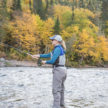All You Need to Know About GoreTex Jackets

What You Need to Know About GoreTex Jackets
We could only see a few yards ahead of us. Dense fog obscured both the trail and the beautiful vistas the guidebook had promised. Wind whipped at the hood of my raincoat, somehow not clearing the fog at all, but managing to drive the rain sideways through every layer of my clothing.
In the north of England, where we were hiking, they have a saying about rain: “It stops at the skin.” But Ania and I had been trekking across open heathland for hours, and I wasn’t so sure. My fingers were pruny in my gloves, and my raincoat seemed to be funneling water down my back. I felt like I had a waterfall running from the nape of my neck to my shoulder blades, where the water just seemed to kind of… soak in.
The story ends happily — with a cask ale by a crackling fire in a country pub — but during the hours I spent trudging along that wet, windswept trail, I knew I needed to learn more about DWR clothing. That’s short for “durable water repellent clothing.”
DWR, Gore-Tex, and Other Brands
DWR jackets are often called “GoreTex jackets,” but they’re not the same thing. Just like lots of us will call any paper facial tissue Kleenex, all plastic bags with sealable openings ZipLocks, and any square note-paper with a removable adhesive backing a Post-It, most of us call breathable waterproof jackets GoreTex, but of course, that’s a brand name. Many outfitters now make their own version, such as Patagonia’s H2No or North Face’s Dryvent.
While each is subtly different, they all basically work the same way: the DWR coating helps rain bead up and roll away without soaking the fabric. Magic! Some manufacturers are even making stretchy DWR jackets now, although I confess I don’t know what sorcery they’re using to make that work.
The unmistakable yellow-and-black GoreTex tag is often the first thing I look for on a rain jacket, because they have a lifetime guarantee against multiple product defects. That means that if your jacket fails, no matter who made it — Patagonia, LL Bean, Marmot, North Face, Mountain Hardwear, Arc’teryx, whatever — you have a much higher likelihood of getting it replaced for free. This is what happened to me after that sodden British hike: I mailed the jacket back to the manufacturer (in this case, made by Marmot) who agreed that it had a rare defect (called “delamination”), which was what was causing the Niagara Falls sensation down my back. They sent me a credit for the original price of the jacket, and I used it to buy a new one.
Of course, other brands and retailers also offer guarantees — but I have had such a good experience with GoreTex that it’s what I recommend.
Layers
The second thing I always look for in a rain jacket is the number of layers the jacket contains. Ultrathin jackets — good for humid, rainy summer days — are sometimes just one layer of fabric with a DWR coating. They’re lightweight and will help you stay dry and (relatively) cool, and they’re often less expensive. But they don’t last very long, and I don’t find them very versatile. Brands don’t usually label these jackets as being only a single layer, but you’ll recognize them by their cheaper price and the “ultralight” language.
Most waterproof shells on the market are 2.5 layers (listed as 2.5L in many product specs). This extra layer means that even if the DWR coating fails and water starts soaking the outer layer of the jacket, you still won’t get wet until the outer layer of fabric totally fails. And some shells have three full layers (3L in the specs) — at this point, you’re getting not only a jacket that will stand up to any rain, but something that offers additional wind protection. It’s going to be durable and last you a long time, but will also cost you more than the others.
Which one is right for you? I’d say the 2.5L is probably in the sweet spot for most folks; I have both a 2.5L and a 3L, and find the 2.5 somewhat more versatile. (The 3L is so thick it makes a crackling sound when I move, and it doesn’t let me move quite as easily as the 2.5L.) If you want a rain jacket for high-intensity, no-contact activities like running or cycling, the ultralight may be enough for you, and help keep you cooler to boot.
Weight
Finally, you can also look at the weight of the jacket if that’s a concern for you. Usually it’s only backpackers who care about weight, but consider whether it’s something that matters to you. Weight and layers don’t always go together — manufacturers can find sneaky ways to make even 3L models surprisingly light, but again, it will cost you. You should be able to find either the total weight of the jacket or the ounces-per-square yard of the fabric.
Features
Now at last you’re ready to consider a jacket’s design features: things like hoods, drawstrings, pockets, cuffs, and so on. There are two that I’ve found really matter to me: first, pit zips (or, using their Sunday name, “armpit zippers”). No pit zips? For me, that’s a deal breaker: these really do let you dump excess body heat. That makes the jacket much more versatile.

Second, I have strong opinions on pocket placement. Most of us aren’t wearing our rain shells to just stand around and look pretty in them; we’re strapping on a backpack or a tool belt over our jackets. This usually means we’re seriously restricting access to our jacket pockets, which are also often right at the waist. And so I always look for jackets with pockets situated well above the waist, so that when I buckle my backpack on, I can still get stuff from my main pockets.
Those are the two features that matter to me, but there may be others on your list — most rain shells today are helmet compatible (meaning the hood will fit over your helmet), and lots have drawstrings that will improve the fit of the jacket and keep the rain from getting in. I also like a nice fuzzy chin guard, to keep the top of the zipper from chafing my chin. Another useful feature is a shell that will let you “zip in” an insulation layer, so that it can keep you dry — and warm — during all four seasons.
Look at a bunch of jackets to see which features matter to you. It’s worth it to spend the time finding the right one — if you choose well, this jacket will be keeping you dry for years to come.
A note on maintenance
Any DWR finish is going to work better if it’s clean. But don’t wash your jacket in any old detergent. Use a specialty soap, like NikWax Tech Wash, or you might damage the jacket. DWR coatings do wear out after a while, but unless you’ve ripped or abraded the jacket, you can usually give them a boost. First, wash the jacket so it’s nice and clean. Then, apply your product. Some of these wash into the DWR item; others you spray on. (Personally, I’ve had better luck with the spray-on option from NikWax.) Often, the DWR-boosting treatment needs to be “cured” with a stint in your clothes dryer.
Thicker jackets (2.5L and 3L) will keep you pretty dry even when the DWR coating is gone, even if you no longer see the water beading up and rolling off.
A note on staying dry
Not even the best waterproof clothes will keep you dry if you’re an idiot. Once when hiking alone along a marshy trail, I stepped on what I was 85% sure was solid ground only to find that it was a bog. I sank in up to my hips, and felt water rushing up through my GoreTex rain pants and down into my GoreTex-lined hiking boots. (This story also has a happy ending: it also ended with a cask ale at a country pub.) Don’t be dumb. Keep the water on the outside of your clothes.














